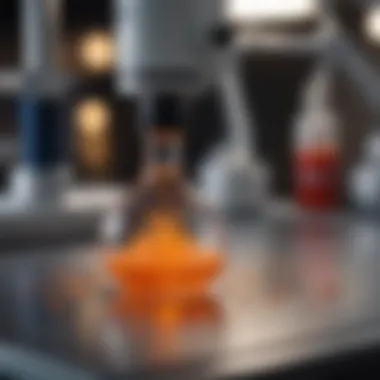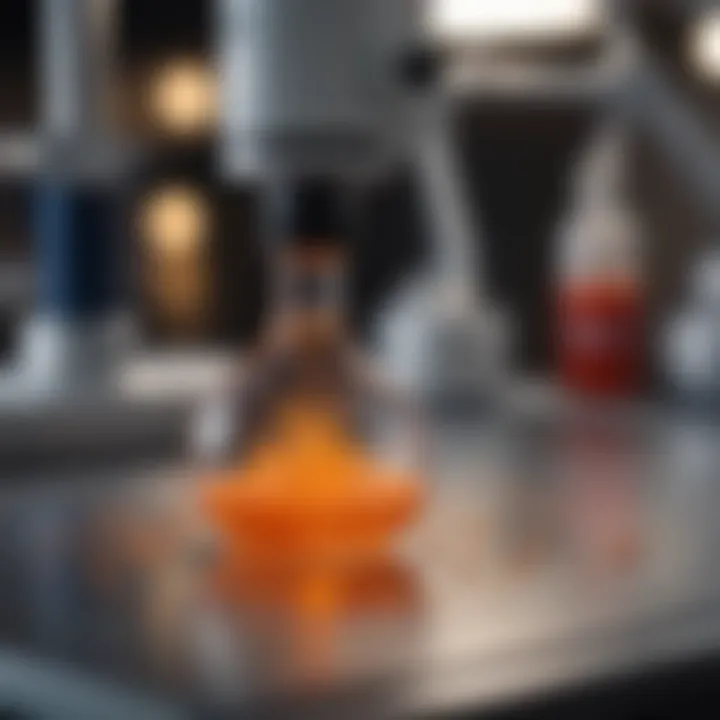Exosome Analysis via FACS: Insights for Biomedical Research


Intro
Understanding cellular communication has been an ever-evolving journey, where factors such as extracellular vesicles have come to the forefront of research. Among these vesicles, exosomes play an essential role in mediating interactions between cells. These small particles, derived from the endosomal system, are released by various cell types and encapsulate proteins, lipids, and RNA. Their ability to carry biologically relevant information makes them pivotal in both physiological and pathological processes.
The exploration of exosome sorting and analysis through Flow Cytometry (FACS) presents groundbreaking opportunities in biomedical research. This technique, known for its precision in analyzing complex mixtures, allows scientists to observe and characterize exosomes based on their size and surface markers. Delving into how these exosomes contribute to health and disease broadens our understanding and paves ways for new therapeutic strategies. Here's what will be discussed in detail: methodologies employed in exosome sorting, their significance in various biomedical applications, and the trends shaping this field.
Research Overview
Methodological Approaches
The assessment of exosomes involves several methods, with Flow Cytometry being a standout due to its high throughput and single-particle analysis capabilities. Traditional methods like Western blotting and nanoparticle tracking analysis provide information but often at the cost of speed and resolution. No wonder why researchers are now favoring FACS, as it offers precise data by sorting exosomes based on size and the presence of specific surface proteins.
A robust approach often combines FACS with techniques like:
- Immunoaffinity capture: This method employs antibodies specific to exosome surface markers, enhancing specificity.
- Nanopore technology: This is gaining traction due to its capability to distinguish between exosome subpopulations, offering richer insights into their heterogeneity.
Such methodologies have unarguably advanced our grasp on exosomal characteristics, but integrating them with clinical samples enhances their relevance in real-world applications.
Significance and Implications
The implications of exosome sorting and analysis are vast, particularly in understanding diseases. For instance, in cancer research, exosomes are known to harbor tumor-specific markers that could facilitate early detection. Their role in intercellular communication opens a treasure trove of opportunities for diagnostics and therapeutics.
From a diagnostic perspective, the profiling of exosomes could revolutionize how we detect conditions like Alzheimer's and inflammatory diseases. Therapeutically, harnessing exosomes as delivery vehicles for drugs or RNA-based therapies presents an innovative avenue to enhance treatment efficacy.
As we delve deeper into these topics, let’s also discuss the current trends shaping this intriguing field.
Current Trends in Science
Innovative Techniques and Tools
Recent advancements in technology are redefining how we analyze exosomes. Techniques like microfluidics enable researchers to study fluid dynamics at the microscale, facilitating the isolation of exosomes with higher specificity. Coupled with machine learning, these innovations promise to bolster our understanding of exosomal functions and dynamics.
Moreover, high-resolution imaging techniques such as super-resolution microscopy provide insights that were once thought impossible. They allow for the visualization of exosomes and their interactions at the cellular level, revealing pathways that may lead to therapeutic targets.
Interdisciplinary Connections
Exosome research is not confined to one field; it bridges a multitude of disciplines. Biochemistry, molecular biology, and engineering all play crucial roles in the development of techniques for exosome analysis. This intersection fosters a rich environment for collaboration, encouraging the application of diverse methodologies and perspectives.
Understanding Exosomes
Exosomes, small vesicles that are secreted by cells, have become crucial players in the field of cellular communication. Their understanding goes beyond mere biology; it bridges gaps between basic science and clinical application. This section aims to explore the fundamental aspects of exosomes, providing insight into their definition, origin, and functions that are pivotal for biomedical research.
Definition and Characteristics
Exosomes are typically 30 to 150 nanometers in diameter, originating from the endosomal system of cells. They carry proteins, lipids, and nucleic acids, acting as tiny carriers of molecular information. Unlike other types of extracellular vesicles, exosomes are formed by the inward budding of the plasma membrane, leading to the creation of multivesicular bodies that eventually fuse with the cell membrane, releasing their contents into the extracellular space.
The characteristics of exosomes position them uniquely in biological systems:
- Composition: They often carry diverse biomolecules, including mRNA, miRNA, and proteins, that reflect the metabolic state of their parent cells.
- Stability: Exosomes are remarkably stable in biological fluids, making them suitable as biomarkers in various diseases.
- Cargo Specificity: Their content can vary significantly depending on the cell type and its physiological state.
The significance of these features cannot be overstated, particularly in the context of disease detection and monitoring.
Biogenesis of Exosomes
Understanding how exosomes are formed provides insight into their functional roles within the body. The biogenesis of exosomes starts with the endocytosis process, where the cell membrane engulfs extracellular material, leading to the creation of early endosomes. These early structures then mature into late endosomes, which subsequently form multivesicular bodies. The membrane of these bodies can then fuse with the plasma membrane, releasing exosomes into the extracellular space.
There are various factors that influence this process:
- Cell Type: Different cells produce exosomes with distinct properties and in varying quantities.
- Stimuli: External factors like stress, inflammation, or growth factors can trigger enhanced exosome release.
- Pathological Conditions: Many diseases, such as cancer, affect the rate and content of exosome secretion, providing potential targets for therapeutic interventions.
Functions in Cellular Communication
Exosomes play an integral role in cellular communication, acting as messengers between different cell types. They can transfer information, influence recipient cells, and modulate various biological processes. Key functions of exosomes include:


- Gene Regulation: By transferring RNA molecules, exosomes can influence gene expression in target cells.
- Immune Modulation: They can modulate immune responses by carrying specific proteins or signaling molecules that can activate or suppress immune cells.
- Facilitation of Tumor Aggravation: In cancer biology, exosomes can carry oncogenic proteins that help in tumor progression and metastasis.
Exosomes represent a fascinating aspect of biological signaling that transcends mere cellular waste disposal, highlighting their potential as targets for diagnostic assays and therapeutic strategies.
"Exosomes are like tiny carriers of molecular secrets, offering insights into the state of the cell and much more."
In summary, understanding exosomes in depth is imperative for leveraging their capabilities in biomedical research. They hold secrets that could unveil new diagnostic markers, treatment options, and a deeper comprehension of intercellular communication.
Principles of Flow Cytometry
Understanding the principles of flow cytometry is crucial for comprehending how exosomes are sorted and analyzed. This technology enables researchers to dissect complex biological systems with finesse, allowing for the identification and quantification of individual exosomes based on unique characteristics. The ability to analyze these extracellular vesicles not only sheds light on their functional roles in cellular communication but also highlights their potential in various biomedical applications.
Flow cytometry operates on the premise of suspending cells or particles in a fluid stream and passing them through a laser beam, which detects and analyzes their properties. This method has found its way into numerous biological disciplines, transforming experimental approaches. Therefore, discussing the fundamentals of this technology is essential for grasping how it can be applied to exosomal research.
Overview of FACS Technology
FACS, or Fluorescence-Activated Cell Sorting, stands out as a premier technique in flow cytometry. What separates FACS from traditional flow cytometry is its ability to not just analyze, but also sort cells based on fluorescent labeling. This means if one’s looking to isolate specific exosomes, FACS can specifically capture them amidst a crowd of other cellular debris or vesicles. The process starts by using fluorescent tags that bind to target exosomes, which are later illuminated by a laser. This illumination produces signals that can be measured, allowing researchers to discern the features of individual exosomes.
The sorting capability of the technology takes things a step further. In a world where precision matters, researchers can direct specific exosomes into separate containers for further analysis or use. This makes FACS indispensable in studies requiring high purity or specific exosome populations.
Key Components and Mechanisms
Digging deeper into FACS, several components play pivotal roles that facilitate the accurate analysis and sorting of exosomes:
- Laser System: Provides the light source necessary for detecting fluorescence.
- Fluidics System: Ensures that streams of particles flow in single file, maintaining a suitable environment for detection.
- Optics System: Collects the emitted light and directs it to the detection devices.
- Data Acquisition System: Interprets the signals and turns them into quantifiable data.
Each key component works harmoniously to allow the flow cytometer to performits duty seamlessly. The customization of FACS systems also permits researchers the flexibility to adapt the technology according to their specific requirements, leading to a more tailored approach to exosomal research.
"FACS technology opens up numerous avenues of exploration, enabling precise manipulation and characterization of biological elements at a resolution that was once thought to be unattainable."
Applications of FACS in Biological Research
Flow cytometry, particularly through FACS, has found immense utility in biological research, and its implications are vast. Here are a few notable applications:
- Characterization of Exosomal Cargo: Researchers can identify and characterize proteins, nucleic acids, or other biological molecules carried by exosomes.
- Disease Biomarker Discovery: By isolating specific exosomes associated with diseases, researchers can identify new biomarkers for various conditions such as cancer or neurodegenerative disorders.
- Therapeutic Screening: Analyzing how exosomes interact with different therapeutic agents paves the way for the development of innovative treatments.
As FACS continues to advance, its application in the realm of exosome research is only poised to grow, shedding light on new aspects of biology and medicine that remain widely unexplored.
Isolating Exosomes for Analysis
Isolating exosomes effectively is paramount to thorough analysis in biomedical research. This process underpins the ability to study these extracellular vesicles' composition and their roles in cellular communication. Exosomes have gained significant attention due to their potential as biomarkers for disease and as vehicles for therapeutic agents. However, to ascertain their utility, researchers must grapple with effective isolation techniques that maximize yield and ensure purity.
Methods of Isolation
Each method of isolating exosomes has its strengths and weaknesses, and the choice of technique can heavily influence the quality of downstream analyses. Here we delve into some prevalent methods, shedding light on their contribution to the field.
Ultracentrifugation
Ultracentrifugation is often considered the gold standard for exosome isolation. This method employs centrifugal force to separate exosomes based on their density. The key characteristic of ultracentrifugation is its ability to yield pure samples with a low level of contamination from proteins or other cellular debris. It forms a crucial part of many lab protocols due to its reliability and reproducibility.
However, while ultracentrifugation can effectively isolate exosomes, it also has its downsides. The lengthy process can take several hours and requires specialized equipment, which may not be accessible for all facilities. Additionally, some delicate exosomes may be susceptible to damage during the stresses of centrifugation. This means careful handling and conditions are vital to preserve their structural integrity.
Exosome Precipitation Reagents
Another approach involves the use of exosome precipitation reagents. These reagents effectively precipitate exosomes from biological fluids through the addition of polymers. A standout feature of this method is its simplicity and speed, providing a rapid way to concentrate exosomes. It is especially useful for larger sample volumes, making it easier to process clinical samples.
One of the attractive factors for researchers is that precipitation reagents often do not require sophisticated equipment, thus lowering the bar for labs seeking to analyze exosomal content. Yet, the downside could be the possibility of co-precipitating contaminants alongside exosomes, which may introduce variability in assay results.
Microfluidic Techniques
Microfluidic techniques present an innovative way to isolate exosomes. This method leverages small-scale fluidic systems to manipulate samples and separate exosomes from other components based on size or surface properties. A unique feature of these techniques is the ability to perform integration of several analytical steps, such as isolation, separation, and further characterization, all on a chip.
The advantages are plentiful. Microfluidic systems are generally less sample-intensive and provide rapid processing times. However, they are still evolving in terms of standardization and reproducibility across different setups. Some might argue that the reliance on intricate designs and the potential for technological variability might pose challenges in comparative studies across labs.


Factors Affecting Exosome Yield and Purity
When delving deeper into isolation methods, factors such as sample type, processing time, and temperature play pivotal roles in influencing exosome yield and purity. For instance, biological fluids such as serum or urine can yield varying amounts of exosomes dependent on the disease state. Moreover, variations in methodologies employed across labs can lead to discrepancies in results.
As researchers in the domain strive for higher standardization and techniques that ensure the integrity of the isolated exosomes, a clear understanding of these factors remains essential. Enhanced yield and purity are crucial, particularly when exosomes are intended for diagnostic or therapeutic applications, underscoring the importance of meticulous methodology in ensuring the success of exosome research.
FACS Analysis of Exosomes
FACS analysis of exosomes has carved a crucial niche in the realm of biomedical research. Understanding how these extracellular vesicles are sorted and analyzed can open up avenues for improved diagnosis and treatment options. Notably, the power of flow cytometry lies in its ability to investigate the unique characteristics of exosomes at an unprecedented resolution. This capability allows researchers to sort exosomes based on size, surface markers, and fluorescent labels. Thus, drawing invaluable insights into their involvement in various biological processes.
Properly employing FACS enables scientists to differentiate between exosomes derived from different cell types, unveiling subtle variations that might otherwise go unnoticed. This not only enhances our comprehension of the pathophysiological roles of exosomes but also provides a clearer understanding of their interactions in cellular communication.
Moreover, by analyzing exosomes using FACS, one can effectively tailor therapeutic strategies. The implications of precision medicine, where treatments are modified according to individual exosomal profiles, stand on the verge of realization. The nuances of FACS thus hold the key to advancing both diagnostic and therapeutic frameworks in biomedical science.
Labeling Exosomes for Detection
The intricacies of labeling exosomes for detection are paramount in FACS analysis. Two prominent approaches that have gained traction are fluorescent markers and surface protein characterization.
Fluorescent Markers
Fluorescent markers have become a cornerstone in the detection of exosomes. One of their defining characteristics is the variety of colors and intensities they can exhibit, making it possible to multiplex studies. This means multiple exosomal populations can be assessed in a single experiment, adding layers of data while conserving precious samples. In context of FACS analysis, the abundance of available fluorescent dyes allows for extensive customization when labeling exosomes. Therefore, the specificity and versatility of these markers play a crucial role in enhancing detection accuracy.
"Fluorescent markers revolutionize the analysis of exosomes, allowing multiple targets to be analyzed in parallel."
Unique to fluorescent markers, their detection is based not only on the fluorescence intensity but also on the size and granularity of the exosomes. This dual functionality paints a more comprehensive picture of the exosome's characteristics. However, a potential drawback lies in the photobleaching phenomenon; fluorescent signals can diminish over time, potentially leading to misinterpretation of results if not properly timed.
Surface Protein Characterization
Surface protein characterization serves as another pivotal method for labeling exosomes. By probing the specific proteins on the surface of exosomes, researchers can glean insights into their origin and functional roles. This method shines particularly in its ability to provide context about the biological interactions these vesicles partake in.
Interestingly, the hallmark of surface protein characterization is its capacity to affirm the exosomal identity and functionality. This provides an added layer of reliability when interpreting FACS data. The use of antibodies that are specific to certain surface markers strengthens this approach, making it a highly favored technique in the realm of exosome research.
However, challenges do exist. The heterogeneity of exosomal populations can complicate the characterization process, and false positives can arise if non-exosomal artifacts are inadvertently labeled. Thus, while advantageous, this method requires meticulous experimental design and control measures to ensure data validity.
Data Acquisition and Interpretation
The data acquisition and interpretation phase of FACS analysis of exosomes is where the theoretical meets the practical. Collecting data from a FACS run involves understanding the complex interplay of parameters such as forward scatter, side scatter, and fluorescence intensity. This interplay forms the backbone of interpreting exosomal data effectively.
In a typical flow cytometry setup, thousands of exosomes can be analyzed in a matter of seconds. The streamlined process allows researchers to generate large data sets suitable for sophisticated statistical analysis. Importantly, the interpretation of this data hinges on creating accurate gating strategies to parse the exosomal populations from noise and background signals.
Training in data interpretation is crucial, as the insights drawn determine the subsequent research directions. With appropriate expertise and experience, scientists can leverage this data to formulate hypotheses, design new experiments, and advance exosome research toward practical applications in diagnostics and therapeutics.
Clinical Implications of Exosome Research
The role of exosomes in clinical settings cannot be overstated. These nano-sized vesicles carry biological signals that can represent the physiological state of donor cells, making them valuable in diagnostics and therapy. A great deal of potential resides in understanding their clinical implications, specifically concerning their use in disease detection and treatment methodologies. As researchers delve deeper into exosome biology and their functions, the future of proactive patient care could be significantly transformed.
Exosomes in Diagnostics
Biomarkers for Disease Detection
Biomarkers offer invaluable information about disease presence and progression. Exosomes serve as important carriers of these biomarkers, encapsulating proteins, lipids, and nucleic acids that reflect the condition of their cells of origin. Notably, the presence of specific surface proteins can indicate particular diseases, providing a comprehensive snapshot of a patient's health.
The key characteristic that positions exosomes as a preferred choice in diagnostics is their ability to reflect the microenvironment of their source cells. This means they can convey nuances that straightforward blood tests might miss. Their unique feature lies in their capacity to integrate multiple types of biological molecules, which can lead to informed clinical decisions.
Advantages: One significant upswing of using exosomes as biomarkers is their non-invasive collection method. Easier sample acquisition, particularly through bodily fluids like blood or urine, is often viewed as a huge benefit. However, one should also consider that while promising, the complexity of isolating and identifying the right exosomal markers poses challenges.
Liquid Biopsy Applications
In the landscape of diagnostic techniques, liquid biopsies have gained traction as a less invasive alternative to traditional tissue biopsies. In this space, exosomes shine brightly due to their rich content of tumor-derived material. Liquid biopsies facilitate the understanding of cancer evolution and offer insights into treatment responses in real-time.
The key characteristic of liquid biopsies is their ability to detect disease mutations in a dynamic and ongoing manner. This is invaluable for monitoring treatment efficacy or checking for the emergence of resistance. The unique feature of employing exosomes in liquid biopsies is their considerable stability in circulation, allowing for repeated sampling over time, thus providing a more holistic view of a patient's condition.
Advantages: The benefits here are largely about patient comfort and the timely information gained. Furthermore, this method shows a solid potential for personalized treatment strategies. However, potential downsides include the ongoing need for standardization and optimization of isolation procedures.


Therapeutic Potential of Exosomes
Drug Delivery Systems
When it comes to drug delivery, exosomes are carving out a niche of their own. They can be engineered to carry therapeutic agents and deliver them directly to target cells, greatly enhancing treatment efficiency while minimizing side effects. With their natural lipid bilayer, exosomes facilitate passage through cellular membranes, making them suitable vehicles for targeted therapies.
The key characteristic that underscores their potential in drug delivery is their biocompatibility and low immunogenicity. They mimic cellular processes, allowing drugs to be delivered without raising alarm bells in the body's immune system. The unique feature of using exosomes for this purpose is their ability to transport a variety of molecules, including nucleic acids and proteins.
Advantages: The major perk is the reduced toxicity associated with traditional delivery methods, enhancing patient experience and treatment adherence. However, the precise targeting and controlled release of drugs remain areas that require further study.
Regenerative Medicine Applications
Exosomes have made significant inroads into regenerative medicine. Their role in tissue healing and regeneration is backed by robust data showing that they can stimulate repair mechanisms following injury. The regenerative potential of exosomes is particularly prominent in areas such as wound healing and organ restoration.
The key characteristic that makes exosomes appealing in this arena is their ability to facilitate intercellular communication, thereby promoting tissue repair and regeneration processes. Unlike conventional methods that rely on scaffolds or cell transplants, exosome therapy potentially provides a simpler, more efficient solution.
Advantages: Using exosomes in regenerative medicine offers a non-invasive approach to treatment, along with lower risks of rejection. However, the variability in exosome production and the need for standardization in therapeutic applications pose considerable challenges for their widespread acceptance.
Understanding these clinical implications of exosomes not only provides insight into diagnostic and therapeutic approaches but also highlights the adaptability of biological materials in tackling modern health challenges.
Challenges in Exosome Research
Research into exosomes has expanded exponentially, but challenges persist. Addressing these issues is not just a side note. They define the quality and applicability of findings in biomedical research. Standardization of protocols and navigating regulatory considerations are two-peas-in-a-pod in this domain. Both are critical for fostering reliable and reproducible results, which are the bedrock of scientific inquiry.
Standardization of Protocols
Standardized protocols are like the referee in a closely contested game; they ensure fairness and consistency. In the realm of exosome research, the absence of unified methodologies can lead to discrepancies across studies, making comparisons a Herculean task. Different isolation techniques, for instance, such as ultracentrifugation or precipitation reagents, often yield exosomes with varying purity and yield. Researchers might end up speaking different languages, even when examining the same type of sample.
Moreover, protocols may vary not just between labs, but even within a single research group over time. Any differences in temperatures, centrifugation speeds, or even the types of materials used can lead to variations in results. This lack of standardization hinders the advancement of knowledge and makes it tough to translate research into clinical settings. Future guidelines should focus on uniform practices that everyone can adopt, ultimately fostering collaboration and collective gains in this field.
To address these challenges, some initiatives are underway to develop consensus recommendations. But, it’s not a quick fix, and it may take a village.
Regulatory Considerations
Regulatory frameworks often feel like walking through a maze. When it comes to exosome research, navigating these regulations can be even trickier. Researchers must ensure that their work complies with local and international guidelines. Each nation has its own set of rules that may differ in the level of oversight they enforce on biotechnological advancements.
The FDA and other health authorities demand that any new diagnostic or therapeutic product incorporating exosomes undergo stringent evaluations. These evaluations can include reviewing the safety and effectiveness of the products before they hit the market. Additionally, researchers often find themselves tangled in ethical considerations around consent for materials sourced from human subjects.
The tension between innovation and compliance can stall potential advancements. Nevertheless, developing clear regulatory pathways is crucial for ensuring that valuable breakthroughs do not get sidelined.
"Without regulatory clarity, the promise of exosome therapies may remain just that—a promise, rather than a reality."
Keeping abreast of ongoing changes in these regulations is vital. As new techniques and findings emerge, flexible and adaptive regulatory measures are essential to allow discoveries to flourish without compromising safety.
In sum, addressing standardization of protocols and regulatory considerations is like laying a strong foundation before erecting a tall building. Both ensure that the weight of scientific rigor upholds the edifice of exosome research.
Future Directions in Exosome Biology and FACS
The landscape of exosome biology is ever-evolving, with new findings and technologies emerging at a rapid pace. This section delves into future directions in exosome biology and the role of FACS in furthering our understanding of these vesicles.
The continued exploration of exosomes has critical implications for fields like diagnostics and therapeutics. As we stand at the intersection of innovation and application, it's crucial to highlight a few specific elements that hold promise for the future.
Emerging Technologies in Exosome Profiling
Innovations in technology are paving the way for enhanced exosome profiling, dramatically changing how we analyze these biological particles.
- Microfluidics: Advanced microfluidic devices are being designed to isolate and analyze exosomes with greater precision and efficiency. This technology enables real-time analysis and can operate with smaller sample volumes.
- Next-Generation Sequencing (NGS): Coupling flow cytometry with NGS provides a robust platform for profiling exosomal RNA. This synergy allows for the detailed study of exosomal content, paving the way for better understanding of disease mechanisms.
- Mass Spectrometry: Mass spectrometry, particularly in combination with FACS, is emerging as a powerful method for analyzing the proteomic profiles of exosomes. It enables the identification of protein signatures that could serve as biomarkers for various diseases.
Incorporating these technologies will not only refine exosome analysis but also broaden its applicability across different biomedical fields. As researchers adopt and adapt these methodologies, the potential for discovering new biomarkers and therapeutic targets becomes increasingly evident.
Potential for Personalized Medicine
The field of personalized medicine is on the cusp of a transformation thanks to advancements in exosome research and FACS techniques. Exosomes, being carriers of molecular information reflective of their parent cells, offer a unique glimpse into an individual’s health status.
- Biomarkers for Individualized Treatment: Exosomes can serve as indicators for specific disease states, allowing for a tailored approach to treatment. By identifying patient-specific profiles, medical professionals can customize therapies that tout higher efficacy and fewer side effects.
- Pharmacogenomics: The integration of exosomal analysis into pharmacogenomics may lead to more effective drug prescriptions. This can help identify patients who are likely to respond favorably to a certain medication or those who may experience adverse effects.
- Monitoring Disease Progression: Continuous monitoring of exosomal profiles over time can provide insights into disease progression and treatment response, shifting the paradigm from reactive to proactive healthcare approaches.
By harnessing the power of exosomes, the potential for creating highly personalized healthcare solutions becomes not just a possibility, but a reality. As this area of research expands, it invites a broader dialogue on ethical considerations, accessibility, and implementation challenges that must be addressed to truly revolutionize healthcare.
“Emerging technologies in exosome analysis could redefine how we approach diagnostics and patient care.”
The interplay between these dynamic areas of research underscores how the future of exosomes and FACS can significantly impact our understanding of human health and disease, offering promising avenues for further investigation.



